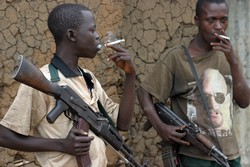“Following attacks by the LRA [Lord’s Resistance Army] in December, there has been a 9 percent rise in the number of displaced in Haut Uélé [near the border with Sudan], and an 11 percent increase in Bas Uélé [near the border with the Central African Republic] compared to earlier months,” said Jean Charles Dupin, head of OCHA in Orientale Province.
Aid workers say 100,000 internally displaced persons (IDPs) are inaccessible due to insecurity in Uélé District. “Since the departure of the Ugandan forces, the LRA has regrouped… The security forces can’t be everywhere, and the LRA is exploiting this situation to attack villages,” said Lt-Col Jean-Paul Dietrich, spokesman for the UN Mission in DRC (MONUC). The joint DRC-Uganda military operation from 14 December 2008 until mid-March 2009 weakened the LRA but did not succeed in neutralizing it. The rebels dispersed in small, highly mobile groups into territory five times bigger than before the operation, according to civil society groups in Ituri.
“The LRA came and broke down our door, and took away four of my daughters, one boy and myself. We spent five days which I will never forget. We suffered a lot. We were starving… They made us carry very heavy things, and if you tried to argue, they killed you,” said Digida Vungu. “We carried people injured in the fighting and fresh cassava; they didn’t even give us water to drink. At night they tied us up so we couldn’t escape,” said Pascal Mubelega. “The LRA uses the people it kidnaps to replenish its forces… Those seized go through a rite of passage involving drugs to embolden them to kill… A child who managed to escape from the LRA was reunited with his family, but one day this child did not think twice about killing his mother over a petty family quarrel,” said Nicolas Mapendo, a journalist coming back from Dungu.
Since December 2007 when the violence began, 1,776 people have died in LRA attacks in the DRC, according to aid workers. Militias within the Front Populaire pour la Justice au Congo (FPJC) and the Front de Résistance Patriotique de l’Ituri (FRPI), having refused to take part in the 2007 disarmament drive, have been very active in Walendu-Bindi territory, especially in the Bunia-Komanda and Aveba-Gety-Bukiringi areas, 70-100km south of Bunia in the eastern part of Orientale Province; in December 2009 six attacks were reported.
Following a 12 January attack by unidentified armed men on eight villages in Zunguluka, 100km south of Bunia, 3,519 families were forced to flee, according to OCHA. The attacks reportedly left six dead; four women were kidnapped and raped before being released. Several buildings were looted and burned down. “We found 56 children walking around naked because all their clothes were gone. More than 108 houses were looted and burned down. Kamapondi and Zunguluka primary schools and the local Anglican church were also torched,” said a senior official from Boga, 120km south of Bunia.
 Some 30,000 IDPs are inaccessible because of insecurity in the south of Irumu Territory, said OCHA’s Dupin. According to Joel Adjiba, an aid worker helping those displaced from Aveba (90km south of Bunia), tens of thousands of people are still effectively kidnapped by militia groups in the Mukatangazi area (140km south of Bunia). “To keep the population under control, the militias are saying ‘anyone who tries to escape will be killed during the upcoming offensive to capture Bunia town. Stay with us if you don’t want to be killed’,” said Adjiba. Left, LRA rebels controlling a village in northern DRC.
Some 30,000 IDPs are inaccessible because of insecurity in the south of Irumu Territory, said OCHA’s Dupin. According to Joel Adjiba, an aid worker helping those displaced from Aveba (90km south of Bunia), tens of thousands of people are still effectively kidnapped by militia groups in the Mukatangazi area (140km south of Bunia). “To keep the population under control, the militias are saying ‘anyone who tries to escape will be killed during the upcoming offensive to capture Bunia town. Stay with us if you don’t want to be killed’,” said Adjiba. Left, LRA rebels controlling a village in northern DRC.
According to aid workers, the total number of IDPs south of Bunia is about 102,000. Ibrahim Diouf, head of the MONUC political affairs office in Ituri, said it was down to the local and central authorities to deal with the militias; MONUC could only provide logistical support. MONUC has 20,000 troops in the DRC; 4,000 are based in Ituri for operations in Ituri, Haut Uélé and Bas Uélé.





